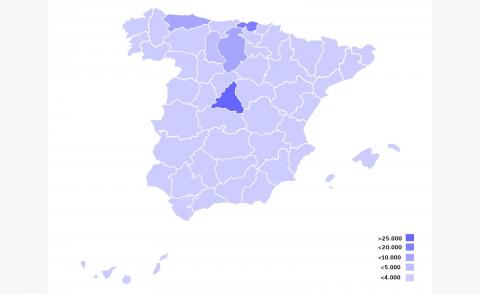
The Covid-19 health crisis has caused major changes in the profile of the tourist that Santander used to welcome; restrictions on mobility between European countries and even between Spanish autonomous communities and provinces have changed the type of tourist and visitor that used to come to your city throughout the year.
But what has happened in Cantabria, and especially in Santander, during those months of confinement and de-escalation? We will tell you in detail.
Santander during the confinement
The first months of the year began with normality as far as tourism is concerned: the international tourists who visited us most were, as always, the French and those from the United Kingdom.
However, at the end of January and February, and at the beginning of March, the figures for tourists and visitors to your city took a turn and began to fall: the pandemic reached Spain, and with it, confinement and restrictions on mobility, which was only allowed in certain cases.
During the months of March, April and May there was a sharp drop in tourism, both national and international. In fact, the latter has undergone such a radical change that during the whole of 2020 it has been almost non-existent.
This drop is even more noticeable when we talk about national and regional holidays and long weekends, where Santander usually receives a large number of Spanish visitors. Several examples of this were:
-Saint Joseph's Day Bank Holiday, from 19th to 22nd March, where there were 4% fewer visits.
-Easter Thursday and Friday, in April, with 76% fewer visitors.
-Labour Day Bank Holiday, in May, with around 49% fewer visitors.
-La Virgen del Mar, on 24th May, with 81% fewer visitors.
These dates usually attract many tourists to your city, but due to the health circumstances and the situation of almost zero mobility, the number of visitors has been considerably reduced compared to other years, affecting Santander at the economic level and local commerce.
What happened during the new de-escalation situation?
The de-escalation process began in June and a period opened up in which, in phases, the country's communities and provinces gradually opened up and allowed mobility. Thanks to these factors, visitors and tourists began to come to Santander from nearby provinces such as Vizcaya, Burgos, Asturias and even Madrid.
As for international tourists, although there was a small upturn, they were almost residual. Those who visited Santander were almost only from France, motivated by the proximity and convenient distance. During this process and summer months, the trend in international tourism continued to fall due to restrictions on mobility between EU countries, unlike other years when summer is the star season for international tourism in Santander.
However, in terms of national tourism, the situation changed: during the summer, Santander was the second most chosen destination by Spaniards and the first of those in the north of Spain.
This can be explained by the fact that, faced with the motivation of the country's most touristic cities to attract tourism in order to make up for the losses of the previous months and "try to save the season", the northern region managed to differentiate itself thanks to its reputation as a "safe region" in the eyes of Covid-19, which some areas such as Asturias and Cantabria were able to achieve. This fact was decisive for national tourism to choose these areas as the best option for their holidays.
However, Santander was the most popular city among tourists, surpassing even cities such as Gijón and Pontevedra, especially during the months of July and August, when the de-escalation phases were completed.
As for the origin of the visitors from the provinces that visited us most during these months, the most numerous, following the usual trend, were those from Madrid and Bizkaia. This upturn in national tourism even exceeded the number of national tourists in 2019.
If you want to know more about how tourism in your city evolved during the summer of 2020 and the de-escalation, don't miss the post "How did the number of tourists in Santander vary in summer?" where we explain all the details.
The effects of the second wave
Once again, with the arrival of the second wave of covid-19 and the new health measures, there was another large drop in tourism, both international, (which as we have mentioned, throughout 2020 has been almost residual) and national, due to the restrictions on mobility between provinces.
As happened during the confinement times, the long weekends and public holidays that used to attract national tourism were severely affected. For example, on 1st November, "Día de Todos los Santos", tourism dropped to less than 91 per cent of the usual number of visitors.
As the number of infected people increased, and with them, the restrictions grew, the number of tourists from Santander went down. A clear example is the Immaculate Conception long weekend, when less than 5,000 visitors came to your city, mostly from municipalities such as Camargo or Santa Cruz de Bezana, and from neighbouring provinces such as Vizcaya.
During Christmas, the situation did not pick up much, although there was a peak in the number of visitors from the 21st to the 31st December, which coincided with the start of the holidays for many. This was possible thanks to the fact that, at this time of year, mobility restrictions were eased somewhat, which meant that many people travelled to spend Christmas with their families, bringing to a close a year of great changes in tourism in your city.
To keep you up to date with everything that is happening in your city and thanks to the SmartCitizen initiative, we will be providing you with the most relevant data on tourism in Santander. In addition, we will improve our municipal services to make them easier to access and use for both you and visitors.

